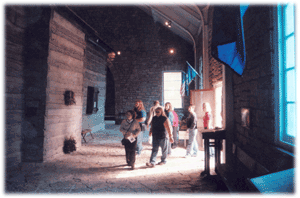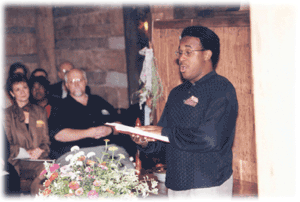The Great Revival

 he time was right in 1801 for the people of middle America to get their souls in order. Settlers of European and African origin, indentured and free, had conquered a frontier - at least they had rendered it manageable. Their farms, towns, and villages were bustling with productive activity. Native Americans had been driven from the land. The
Kentuckians' spirit of energetic application to any emerging questions had spawned countless divisions and now it was on the verge of nurturing a semblance of unity.
he time was right in 1801 for the people of middle America to get their souls in order. Settlers of European and African origin, indentured and free, had conquered a frontier - at least they had rendered it manageable. Their farms, towns, and villages were bustling with productive activity. Native Americans had been driven from the land. The
Kentuckians' spirit of energetic application to any emerging questions had spawned countless divisions and now it was on the verge of nurturing a semblance of unity.
Barton Warren Stone, pastor at Cane Ridge Presbyterian Church, had taken advantage of various networks of communication, especially Methodist and Presbyterian meetings, to circulate word that the Cane Ridge sacramental communion was to be "one of the greatest meetings of its kind ever known." Congregations and pastors, determined not to miss it, packed up for journeys from not only Central Kentucky but also southern Ohio and northern Tennessee.
Sacramental communion events in the months preceding the one scheduled to begin
in early August at Cane Ridge had attracted thousands of people - 4,000 at Concord, 6,000 at Lexington, and 10,000 at Indian Creek in Harrison County. The atmosphere was electric. Travelers from nearby and not so nearby began arriving on Friday, August 6, amidst a downpour of rain. By Saturday a Methodist neighbor Ilai Nunn observed that his grove was a part of the setting.
 Colonel Robert Patterson, who had been involved in
the settlement of Kentucky practically from the beginning, described with amazement the religious
phenomena taking place during the sequence of meetings. His description of the Cane Ridge Revival, taken from a letter to the Rev. Doctor John King on September 25, 1801, is memorable:
Colonel Robert Patterson, who had been involved in
the settlement of Kentucky practically from the beginning, described with amazement the religious
phenomena taking place during the sequence of meetings. His description of the Cane Ridge Revival, taken from a letter to the Rev. Doctor John King on September 25, 1801, is memorable:
"On the first Sabbath of August, was the Sacrament of Kainridge, the congregation of Mr. Stone. - This was the largest meeting of any that I have ever seen: It continued from Friday till Wednesday. About 12,000 persons, 125 waggons, 8 carriages, 900 communicants, 300 were struck. . . "
Patterson tried, "as well as I am able," to describe the emotion. "Of all ages, from 8 years and upwards; male and female; rich and poor; the blacks; and of every denomination; those in favour of it, as well as those, at the instant in opposition to it, and railing against it, have instantaneously laid motionless on the ground. Some feel the approaching symptoms by being under deep convictions; their heart swells, their nerves relax, and in an instant they become motionless and speechless, but generally retain their senses. . . He went on to describe other manifestations which continued from "one hour to 24".
"In order to give you a more just conception of it," Patterson continued, "suppose so large a congregation assembled in the woods, ministers preaching day and night; the camp illuminated with candles, on trees, at wagons, and at the tent; persons falling down, and carried out of the crowd, by those next to them, and taken to some convenient place, where prayer is made for them, some Psalm or Hymn, suitable to the occasion, sung. If they speak, what they say is attended to, being very solemn and affecting - many are struck under such exhortations. . . Now suppose 20 of those groups around; some rejoicing, and great solemnity on every countenance, and you will form some imperfect idea of the extraordinary work!
"Indeed it is a miracle, that a wicked unthoughtful sinner, who never could, or did address himself, to an audience before, should, rise out of one of those fits and continue for the space of two hours recommending religion and Jesus Christ to sinners, as a lovely Savior, free willing, and all sufficient, and calling to sinners and inviting them to come to Christ and close in with the offer of salvation, in the most pressing an engaging manner." (Source: Extract of a Letter from Colonel Robert Patterson, of Lexington, Kentucky to the Reverend Doctor John King, September 25, 1801.
Cane Ridge Meeting House. All Rights Reserved.